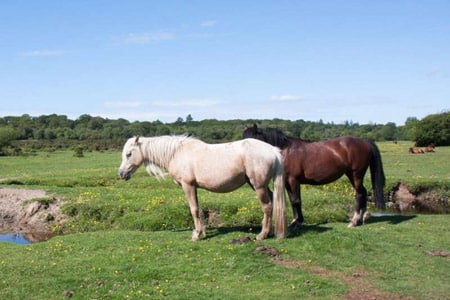In the southern Landes region, near Bayonne, the Barthes de l’Adour occupy a special place in the local natural heritage. This protected site, so rich and diverse, remains little-known to most people in the Landes region. And yet, it offers one of the most beautiful landscapes in the Landes region, and is home to an abundance of plant and animal life. We tell you all about it!

What are barthes?
In the southern Landes region and the Basque Country, barthes (from the Gascon barta) refer to the marshy alluvial plains bordering rivers, notably the Adour. This “green corridor” covers some 12,000 hectares of wet and marshy meadows, crossing 40 Landes communes between Pontonx-sur-l’Adour and
Tarnos
just outside Bayonne. Covering 30% of the wetlands in the Landes region, these flood zones have been man-made since the 17th century to contain the river’s raging currents.
Classified as a Natura 2000 site, these floodplains of theAdour provide a precious biotope for a rich and diverse flora and fauna. The Barthes de l’Adour are the cradle of the Landais pony, an ancient breed that today maintains the wet meadows of the local barthes. On your walks, you may also come across Barthais horses and Landaise cows, for whom grazing with their feet in the water is not a problem.
The Barthes de l’Adour is an important resting and nesting area for many migratory birds, including cranes, white storks, geese and ducks. Sedentary breeding birds are present all year round. Among them are grey herons, ox herons, little egrets, sandpipers and a few birds of prey. Nearly 143 bird species are present, including 78 regular breeders and 31 rare species.
All year round, guided tours and events are organized to help you better understand the functioning of the Barthes ecosystems and observe the birds in the lower Adour valley. The best observation spots are in the Saint-Martin-de-Seignanx reserve, but also in the Barthes d’Hossegor.
Hiking in the Barthes de Saint-Martin-de-Seignanx reserve
In the heart of the Barthes de l’Adour, in the commune of Saint-Martin-de-Seignanx, just five kilometers as the crow flies from our
Les Landes campsite
the Lesgau nature reserve is a 100-hectare natural site classified as an “Espace Naturel Sensible” (ENS). The reserve has been specially designed to provide a resting place for migratory birds, which travel thousands of kilometers before settling in the reed beds and tall grasses.
At the entrance to the Barthes reserve, an observatory (mirador de Saint-Martin) allows you to observe the wildlife of the Barthes du Seignanx without being seen. From December to February, the migration of grey cranes is a spectacle not to be missed.
- Departure from Route d’Arremont, Saint-Martin-de-Seignanx, distance: 5 km loop, duration: 2h, difficulty: easy
Walk in the Barthes de Monbardon, Hossegor
À
Hossegor
the Monbardon barthes are a veritable sanctuary for wild flora and fauna. A short footpath immerses you in the reedbed, where you’ll come across a host of nesting and migratory birds, insects and butterflies. An ornithological hut on stilts allows nature lovers to observe the birds of the Barthes d’Hossegor without disturbing them.
In summer, naturalist guides offer botanical walks to learn how to recognize plants typical of wetlands: marsh hibiscus, willows, alders, bald cypresses, as well as a few carnivorous plants.
- Circuit des Barthes de Monbardon, start: Angresse, distance: 10 km loop, duration: 2h50, difficulty: easy
Photo@Karen Arnold
